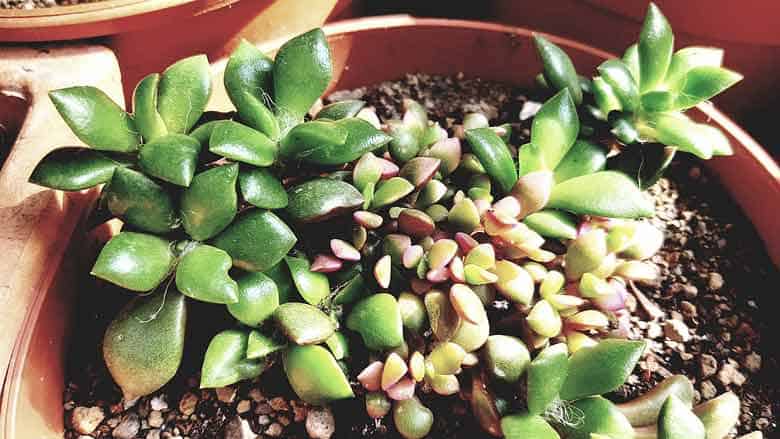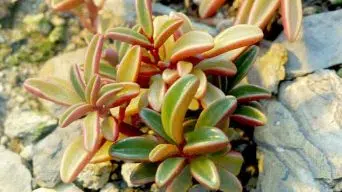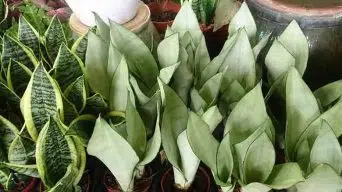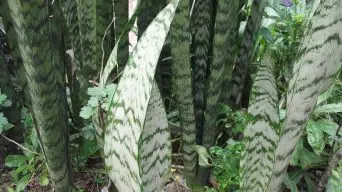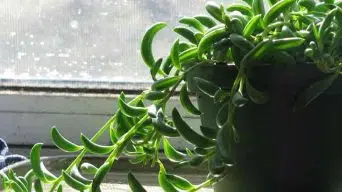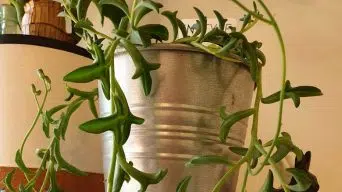Anacampseros Rufescens is a succulent plant with an appearance that resembles the desert. It produces light pink flowers and has a wide, short-pointed rosette of leaves.
Anacampseros rufescens care is very easy, which makes them perfect for beginners!
In this guide, you’ll learn everything about how to take care of and propagate your Anacampseros Rufescens plants!
Anacampseros Rufescens Description
Anacampseros rufescens, or the ‘Sunrise Succulent’, is a small perennial succulent with upright stems that can grow to about 18-24 inches tall.
The leaves are light green and speckled white, which creates an attractive contrast against their bright pink flowers.
The first significant difference between A. rufescens and other members of its genus is its hairiness.
The stems can be covered in white, gray, or brown hairs that give it a unique look when compared to its more typically leafy cousins.”
The second significant difference is the shape of the leaves and their coloration. Like most other succulents, A. rufescens has small fleshy leaves stacked on top of one another like shingles on a roof.
However, these tend to grow less than an inch long while also being light green with dark green stripes running down each side.
The third significant difference is the number of leaves on a stem. A. rufescens only produces an odd number of them, which usually result in five to seven leaves per section.”
A final significant difference between this plant and others in its genus is that it tends to grow atypically prostrate (lie flat) rather than growing upright like other family members.
There are many different reasons why plants behave this way. Still, one popular hypothesis suggests that they do so as part of their survival strategy when dealing with drought conditions.
It’s also worth noting that while all members of Anacampseros have pink flowers, these produce smaller blooms than most other species.
For succulents, the A. rufescens is a very rewarding plant to grow and propagate thanks to its charming pink coloration that it shares with all members of this genus.
How To Care for Anacampseros Rufescens
The Anacampseros Rufescens, commonly known as the ‘Sunrise Succulent’, is a popular indoor plant. Unlike many other succulents, this one thrives in light and is very easy to take care of!
Sun Exposure & Light Requirements
Anacampseros rufescens requires a lot of bright light and is, therefore, best grown in an open space with full sun exposure, such as on the windowsill.
The plant can tolerate some partial shade during midday hours (it will just grow more slowly).
But it needs to have at least six hours of direct sunlight each day. Ideally, it will have eight to ten hours of sunlight per day.
In terms of lighting, the plant also requires indirect light from an east or west-facing window.
To increase the chances that your Anacampseros succulent will flower, you need additional light sources, such as artificial lights or windows with sunlight during winter when there are fewer daylight hours.
For the best results, it also needs to be placed in a location protected from nighttime frost and will receive some rain.
In cases of limited light exposure, you can supplement with artificial lighting during daytime hours by placing the plant near a bright yellow LED bulb (or fluorescent).
You’ll want to use an LED bulb or fluorescent light rather than a regular incandescent since those will emit the appropriate wavelengths of light.
If you place your plant near artificial lighting for prolonged periods (more than 12 hours per day), it is important to put your plant far away from any lights. This way, it will not burn the leaves or make it leggy.
Watering Requirements
Keep the soil on the dry side. This succulent is drought tolerant and prefers to be watered less than other plants in your garden.
The best time of day to water this plant is either early morning or late evening, so it will have enough time to dry off during the heat of midday sun.
If you like to follow watering schedules, then this is what you should do:
- Water once every one to two weeks with about one liter per square meter.
- If the soil of your succulent is very dry, you can water it more often.
- You can also soak them with the hose occasionally during really hot weather. But don’t let them sit in standing water because rot can set in quickly.
- If you live in an area with high rainfall, consider letting the soil dry out in between waterings. You may need to water it once every two or three months.
Soil Requirements
The soil for the succulent should be dry and well-drained.
If you live in a humid area, it is better to use cacti and succulent soil mix or sphagnum moss, as this type of dirt can absorb more water.
Make sure that these types of soils never become too wet. If they are, then your plants will start to rot from the roots up.
If you are having an issue with the soil being too wet, it is better to use a heavy layer of gravel at the bottom and top. This will ensure that everything stays well drained but doesn’t become too dry.
Start with the gravel at the bottom and cover it with a thin layer of cacti mix. As you plant your Anacampseros Rufescens, make sure there is still plenty of empty space left between each one so they have room to grow.
It’s better if they are planted around an inch apart from each other, as this will allow more air circulation for them both.
When planting succulents like these, use porous soil or some dirt that can absorb water but do not let it get wet for too long because this could cause rot problems below.
If you want to add potting medium on top, just sprinkle enough over the top until everything feels moist but not wet.
Temperature and Humidity Requirements
Anacampseros rufescens thrives in temperatures from 45-65 degrees Fahrenheit (USDA zone 11). During the winter, they prefer a temperature between 55 to 60 degrees F°.
Keep your Anacampseros out of drafts and away from heating vents or fireplaces where it might get too hot.
In summer, keep them well-ventilated with plenty of water to stay at least 60 degrees F° but no warmer than 75 degrees F° for optimum growth rate.
Anacampseros rufescens can take a small amount of frost, but it is not recommended to make them cold.
It should also be noted that they are sensitive to moisture loss and start drooping if the air becomes too dry for an extended period.
Anacampseros rufescens prefers a daytime humidity of 50% to 70%. Please note that this is based on the relative humidity felt by your skin.
If you cannot feel any moisture in the air, then it means that there is too little humidity and needs to be increased.
Conversely, if everything feels wet or sticky, it most likely has excess humidity, which should be reduced for optimum growth conditions.
If there is condensation on the windows near a plant, then it means that the room has too much humidity. The plant will not grow, and leaves can get burned.
Fertilizing Your Anacampseros Rufescens
Established plants should be fertilized once a year in the spring. To get established, use an all-purpose fertilizer to feed flowers and foliage according to the label directions.
For mature plants, mix or dissolve 20% of your usual amount of dry fertilizer into the water until it is entirely dissolved before watering as usual.
Do not overfeed Anacampseros Rufescens succulents with nitrogen. This causes them to grow too quickly and then die off quicker than desired because they have outgrown their support system (their container).
You can also try giving them some phosphorous, which will make more blooms form on the plant if you want that kind of look for indoor or outdoor decorating purposes.
Potting and Repotting
The best time to repot an Anacampseros is in the spring when it starts growing again.
However, if you wait too long and your plant outgrows its pot size by September or October, this can result in root rot and plant death.
To avoid these issues, we recommend switching pots every year so that they don’t have to be planted as deep each season due to overgrowth.
When transplanting a succulent from one potting container into another (or soil), use a well-draining soil such as cactus mix with added perlite.
The roots should not sit wet for more than an hour after watering.
- Make sure you prepare a pot that is the right size and has a good mix of things like cactus mix with perlite.
- Water the plant before putting it in the pot.
- When removing the plant from its current pot, use a sharp knife not to damage the roots when cutting through drainage holes.
- Water your plants again after you transplant them. This will help them get used to their new surroundings.
When repotting, make sure not to overwater. Don’t let your plant’s roots sit wet for more than an hour after watering.
If you are moving your succulent to a new container, make sure you water it before you plant it.
Put it in the water and then let it drain. This will help prevent air pockets from forming around the root ball and add moisture necessary for proper transplanting success.
Pruning
Many people are under the misconception that Anacampseros rufescens plants can grow without pruning, but this is not true.
The plant needs to be trimmed and shaped often so it doesn’t grow out of control. This will help make sure you get a healthy shape for your succulent and keep its appearance up longer than if left unchecked.
When you first get your plant, start by trimming off any dead or damaged leaves. This will help make it look nicer and healthier.
After a few months, retake some time to shape the plant as desired – cut off all of the old growth on the outside edge to create new growing points closer to its center.
Cut back any branches that have grown too long and remove lower leaves if they’re not needed anymore (then fertilize).
You can pinch out a tip that is growing the wrong way by pinching it. This is better if more than one node grows in that place because only one branch will grow, not two branches fighting for space.
Flowering
Anacampseros rufescens flowers are a dark pink color. They bloom during summer and can produce up to 20 flowers per year.
Succulents don’t really flower, but some have been known to produce small flowers in late summer and fall that are usually pink or white (these plants tend to require more sunlight than most).
If you want your Anacampseros rufescens to bloom, you can try placing it outside during the day for about a month while keeping it inside at night so they get 12 hours of light each day.
When moving them back indoors after flowering has finished, make sure their new home is brightly lit with lots of indirect natural light from an east-facing window.
This way, they will be able to take shelter from direct sun when needed.
Pests and Diseases
Pests and diseases play an essential role in the life cycle of a succulent. Anacampseros rufescens is not immune to these pests and diseases, but it’s far more resistant than other succulents.
Pests
Pests that can affect Anacampseros rufescens plants are mealy bugs, spider mites, and scale.
These pests will often appear as fuzzy or sludge-like patches on the leaves and stems of your plant. They suck out the sap from the succulent, which causes it to wither away, eventually killing it in a few days if not stopped.
To treat these pests, wipe them off with rubbing alcohol dipped cotton swabs.
Clean up their habitat by spraying thoroughly around baseboards, window sills, etc.
Then remove any dead organic matter within three feet of your plant’s pot.
The best prevention is keeping your plants healthy through adequate light exposure and watering.
Diseases
Anacampseros rufescens plants are susceptible to fungal diseases such as leaf spots and root rot. These can usually be identified by their dark, circular shape on the leaves or small black specks that appear on the soil’s surface.
To treat these problems, cut away any diseased areas of your plant with a sterilized blade.
Then use an old toothbrush dipped in rubbing alcohol to gently scrub off the fungus from infected parts of your succulent. In the winter, your plant will need less water.
To prevent infections, make sure to water your plant only when its soil feels dry to the touch while avoiding letting it stay too wet for too long (this promotes rot).
In addition, try not over-potting, so there is enough space between each succulent.
Keeping it out of drafts or under a heater is also important. This can help lower the chance of diseases.
How To Propagate Anacampseros Rufescens
Anacampseros rufescens can be propagated by either cuttings or seeds.
Cuttings
Leaf cuttings are the easiest way to propagate an Anacampseros rufescens.
Leaf cuttings should be taken from a healthy, mature plant with leaves that have dropped their petiole (the stem of the leaf).
The best time to take the stem cuttings from the mother plant is in spring when they will most likely root quickly and successfully indoors or outdoors.
We recommend using plants with new growth to ensure they grow many roots.
After selecting your cutting material for propagation, dip the leaves into a rooting hormone before planting in soil or sand.
Finally, keep the newly rooted plants in an area with plenty of light and water.
The propagation process should take place indoors or outdoors, depending on your climate zone during these hot months.
Seeds
To propagate new Anacampseros Rufescens plants from seed, sow them in cell packs and grow them as you would any other succulent.
- Sow three to six seeds per pot; they will germinate within about one week if conditions are suitable.
- Keep warm (at least 20°C) at all times until after their first year
- Do not expose to direct sunlight during this time – it may cause “sunburn”, which can kill young seedlings
- If not grown in an appropriate place, the seedlings will become too long and spindly for their own good
- Once they are about a year old (after their first winter), plants can be transplanted to larger pots or put outdoors.
- These plants require time and patience, so be sure you are willing before setting out with your new seedlings!
Is the Anacampseros Rufescens Toxic?
Toxic plants can be a huge concern for people who are inexperienced in indoor succulent care.
The Anacampseros Rufescens plant is not toxic, so you don’t have to worry about that!
Toxic plants will usually have an unpleasant flavor and produce some chemical reaction when they come into contact with skin or other surfaces.
Final Thoughts
The Anacampseros Rufescens is easy to care for, a beautiful succulent that makes a fantastic addition to any home or office.
The plants are relatively small, so they don’t take up too much space and require little maintenance once established.
They make a great gift or plant for the living room, office desk, kitchen windowsill, and more.
Just be sure to provide them with plenty of light to receive enough sun exposure to thrive!

